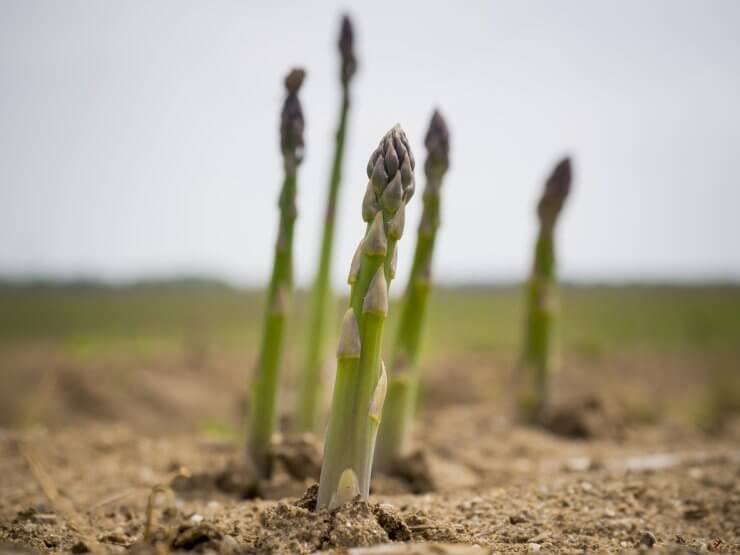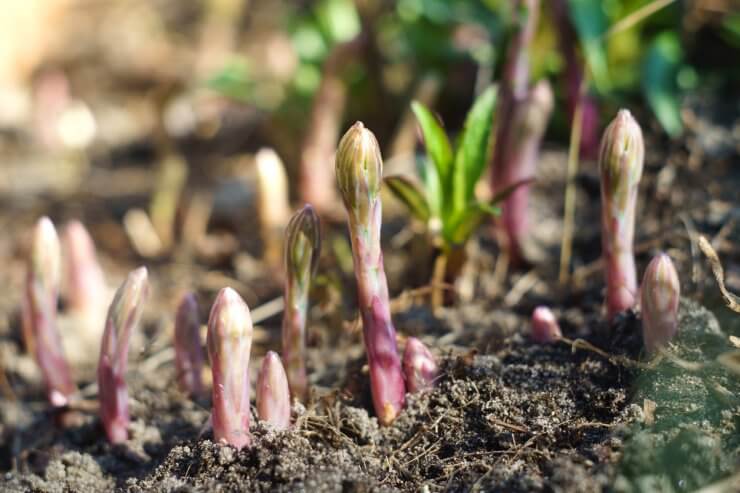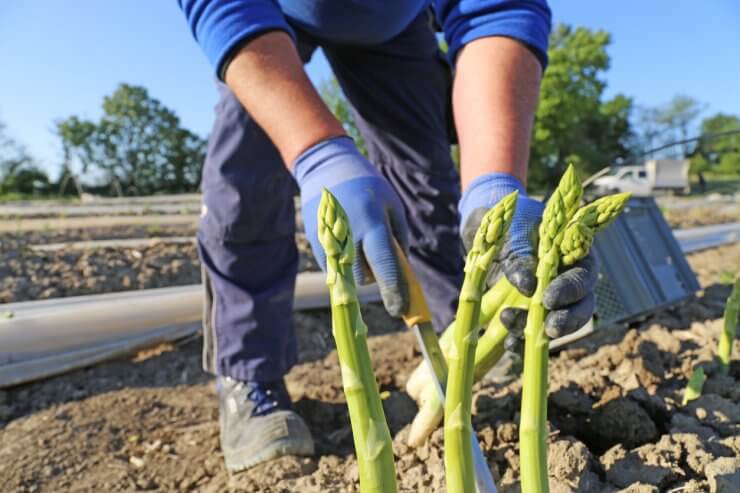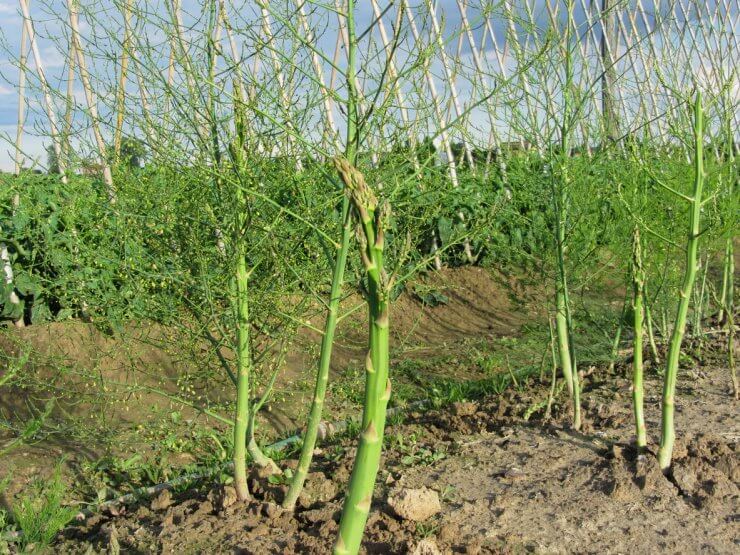
Picture harvesting fresh asparagus spears from your garden just as the sun pops its head up in the spring – it’s a gardener’s dream that requires a gardener’s greatest virtue: patience. While your neighbors are bragging about their quick crops of lettuce and radishes, you’ll be playing the long game with asparagus.
But here’s the magic: once these perennial powerhouses get going, they’ll reward your patience with 15 to 20 years of farm-fresh spears, making them the gift that keeps on giving. Think of it as the difference between a summer fling and a long-term relationship – those several years of waiting might test your resolve, but the payoff is worth every moment.
Ready to commit to this long-term garden romance? Let’s explore why asparagus takes its sweet time, clever ways to speed up the process, and how to know when it’s ready to pick. With a little knowledge and a lot of patience, you’ll be on your way to growing an asparagus patch that could feed your family for decades.

Why Asparagus Takes So Long to Harvest
The long wait for an asparagus harvest is due to the way the plant develops. Unlike annual vegetables that complete their lifecycle in one season, asparagus is a perennial crop that requires time to establish a strong root system before it can be harvested sustainably.
1. Asparagus Needs a Deep Root System
When you plant asparagus from crowns or seeds, the first priority for the plant is root growth, not spears. The plant spends its early years developing deep, energy-storing roots that will fuel future harvests. If spears are harvested too soon, it can weaken the plant and reduce its productivity in the long run.
2. The First Spears Must Be Left to Grow
In the first couple of years, any spears that emerge should be left untouched so they can grow into fern-like foliage. These ferns capture sunlight and send energy to the roots, further strengthening the plant for future years. Removing spears too early stunts this process and delays the bed’s full potential.
3. The Plant Matures Slowly Over Time
Asparagus grows in cycles. The first year, roots establish themselves. The second year, more foliage develops, increasing the plant’s energy reserves. By the third year, a small harvest is possible, and by year four, the bed should be fully mature, producing a full crop of tender spears each spring.

Can You Harvest Asparagus Sooner?
While asparagus naturally takes time, there are a few ways to speed up the process and enjoy a harvest earlier than usual.
1. Start with Asparagus Crowns Instead of Seeds
Growing asparagus from seeds takes an extra year or two before harvesting is possible. Instead, plant one- or two-year-old crowns purchased from a nursery. These crowns already have an established root system, cutting down the wait time for harvest.
2. Choose Faster-Growing Varieties
Some asparagus varieties reach maturity faster than others. Hybrid varieties like ‘Jersey Giant’ and ‘Jersey Knight’ tend to grow more quickly and produce high yields sooner than older heirloom types.
3. Provide Optimal Growing Conditions
A well-planned asparagus bed will grow faster and stronger. To help your plants establish quickly, make sure to:
- Plant in full sun (at least 6-8 hours of direct sunlight per day)
- Use nutrient-rich, well-draining soil
- Add compost or aged manure before planting to boost soil fertility
- Keep weeds under control to prevent competition for nutrients
4. Be Patient with Early Harvesting
Some gardeners try to harvest a few spears in year two, but this should be done sparingly—if at all. Harvesting too soon can weaken the plants and slow long-term productivity. If you must pick a few spears early, limit yourself to only 1-2 weeks of light harvesting in the second year.

When to Harvest Asparagus
Once an asparagus bed is fully established, harvesting happens each spring when the first spears emerge.
Signs Your Asparagus Is Ready to Harvest
- Spears are 6-8 inches tall and about pencil-thick
- Firm and straight growth with tight tips
- Early spring timing, usually starting in March or April depending on climate
How to Harvest Asparagus the Right Way
- Use a sharp knife or garden shears to cut spears just above the soil line
- Alternatively, gently snap spears at the base—they will naturally break at the tender point
- Harvest daily during peak season to keep new spears coming
- Stop harvesting after 6-8 weeks, allowing spears to grow into ferns for the next season’s energy storage

Caring for Your Asparagus Bed After Harvest
Proper post-harvest care ensures continued productivity for years to come.
1. Let the Foliage Grow
After harvesting ends, remaining spears should be left to grow into tall ferns. These ferns feed the roots and prepare the plant for next year’s growth.
2. Mulch and Fertilize
- Apply a layer of compost or aged manure in late summer to enrich the soil
- Mulch with straw or leaves to retain moisture and suppress weeds
- Fertilize with balanced organic fertilizer in early spring to promote strong spears
3. Cut Back in Late Fall
Once the ferns turn yellow and die back in fall, cut them down to ground level to prevent pests and diseases from overwintering.
Asparagus requires patience, but once established, it rewards gardeners with decades of fresh, homegrown spears each spring. While it takes time to develop a strong root system, there are ways to speed up the process by starting with crowns, selecting fast-growing varieties, and maintaining optimal growing conditions.
By waiting until the plant is mature, harvesting at the right time, and caring for your bed after the season, you’ll ensure a thriving perennial vegetable garden that produces abundant asparagus for years to come.
Invest the time, and your future self will thank you every spring when the first spears start to emerge. With our Asparagus Gardening Guide, you’ll have everything you need to know about growing and enjoying this versatile food.
What’s your favorite thing about growing asparagus? If you haven’t tried yet, what’s stopping you?


 Previous
Previous

